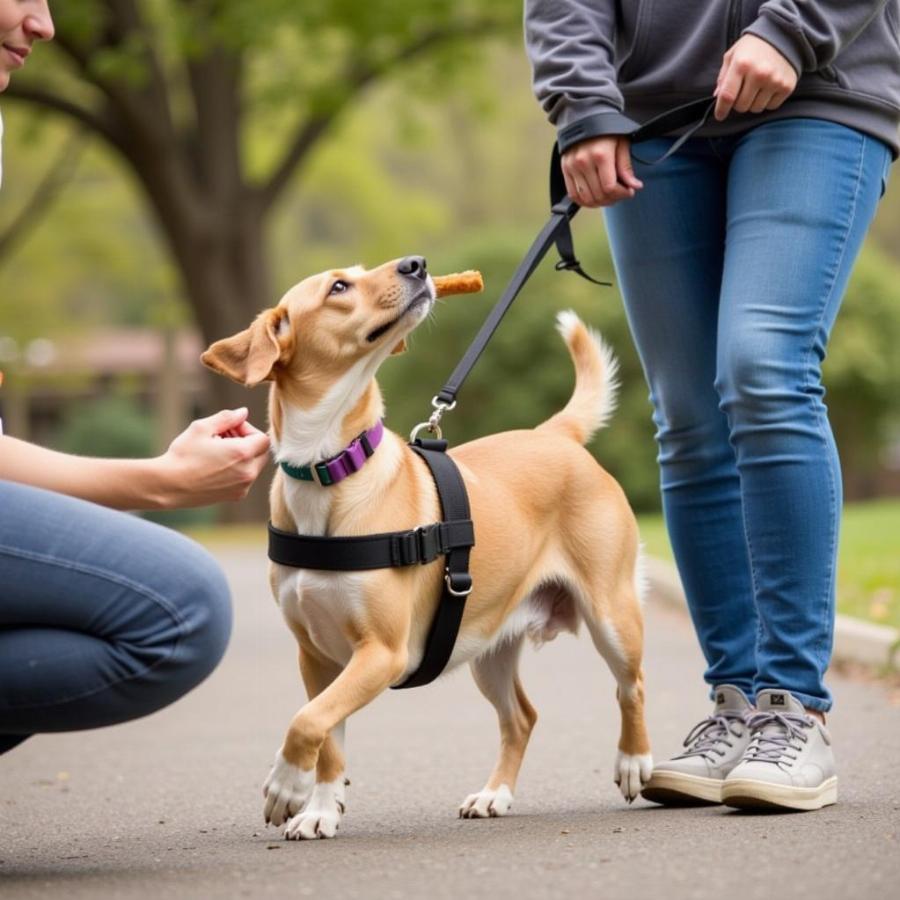Dog training tools are essential for shaping your furry friend’s behavior, strengthening your bond, and ensuring a harmonious life together. Whether you’re welcoming a new puppy or working with an older dog, choosing the right tools can make all the difference in your training journey. This comprehensive guide will walk you through the various dog training tools available, their uses, and how to choose the best ones for your dog’s needs.
Understanding Different Dog Training Tools
Choosing the right tools is crucial for effective training. Some tools focus on positive reinforcement, while others offer gentle corrections. Understanding the different categories will help you make informed decisions. Collars, leashes, harnesses, clickers, whistles, treats, and toys all play a vital role in shaping your dog’s behavior and communication. Remember, each tool has a specific purpose and should be used correctly to ensure your dog’s safety and well-being.
Collars, Leashes, and Harnesses: The Foundation of Control
Collars and leashes are essential for controlling your dog during walks and training sessions. A flat collar is a standard choice for everyday use, while a martingale collar offers more control for dogs who tend to pull. Harnesses provide a more comfortable and secure way to walk your dog, especially for smaller breeds or dogs with respiratory issues. Choosing the right leash length and material is also important, depending on your dog’s size and activity level. Consider a shorter leash for training and a longer one for casual walks.
Clickers and Whistles: Communicating Clearly
Clickers and whistles are excellent tools for communicating specific commands to your dog. A clicker emits a distinct sound that marks the desired behavior, followed by a reward. This positive reinforcement method helps your dog understand what you expect. Whistles can be useful for recall training, especially in open spaces. The high-pitched sound carries farther than your voice, making it easier for your dog to hear you from a distance.
Treats and Toys: Motivating Your Furry Friend
Treats and toys are powerful motivators in dog training. Use small, high-value treats that your dog loves to reward good behavior. Toys can also be used as rewards, especially for dogs who are more play-driven. Interactive toys, like puzzle toys, can also keep your dog mentally stimulated and engaged.
Choosing the Right Dog Training Tools
The most effective dog training tools are those suited to your dog’s individual needs and your training style. A small dog might benefit from a lightweight harness, while a larger breed may need a sturdier collar and leash. Consider your dog’s temperament, age, and training goals when choosing tools. For example, a muzzle for small dogs might be necessary for certain situations.
What are the best dog training tools for puppies?
Puppies require specific tools that cater to their small size and developing needs. A lightweight collar and leash, soft treats, and interactive toys are ideal for starting puppy training. Avoid using harsh tools or methods that could scare or injure your puppy. Positive reinforcement is key for building a strong foundation for future training.
What are the best tools for leash training a dog?
Leash training requires patience and consistency. A comfortable harness, a standard leash, and high-value treats are essential for teaching your dog to walk politely on a leash. Avoid retractable leashes during training as they can encourage pulling. Positive reinforcement and consistent practice will help your dog become a well-behaved walking companion.
 Dog leash training with harness and treats
Dog leash training with harness and treats
Conclusion
Dog training tools are invaluable resources for building a strong bond with your furry companion and ensuring a happy and well-behaved dog. By understanding the different types of tools available and choosing the right ones for your dog’s specific needs, you can set yourself up for success in your training journey. Remember, patience, consistency, and positive reinforcement are key to effective dog training. Don’t forget to check out our other helpful articles on dog learning toys and zoetis products for dogs for more information on keeping your dog happy and healthy.
FAQ
- What is the most important dog training tool? Consistency and patience are the most important tools.
- Are shock collars effective for training? Shock collars can be harmful and are generally not recommended. Positive reinforcement methods are more effective and humane.
- Can I train my dog without any tools? While tools can be helpful, you can train your dog using voice commands, hand signals, and positive reinforcement.
- How do I choose the right size collar for my dog? Measure your dog’s neck and add two inches to find the appropriate collar size.
- What are some good treats for dog training? Small, soft, and highly palatable treats are ideal for training.
- How often should I train my dog? Short, frequent training sessions are more effective than long, infrequent ones.
- When should I start training my puppy? You can start training your puppy as soon as you bring them home, focusing on basic commands and socialization.
Other Questions You Might Have
- How can I stop my dog from pulling on the leash?
- What are the best ways to crate train my dog?
- How do I teach my dog to come when called?
Check out these articles on our site for more information: how to get dog smell out of couch and foster farm corn dogs.
Beaut Dogs is your one-stop resource for all things dog-related. We offer expert advice, helpful tips, and a wealth of information on dog breeds, care, and training. When you need assistance, don’t hesitate to contact us at [email protected] (Email address) for detailed and accurate answers. Beaut Dogs is committed to helping you provide the best possible care for your beloved canine companion. Visit us today at https://beautdogs.com!